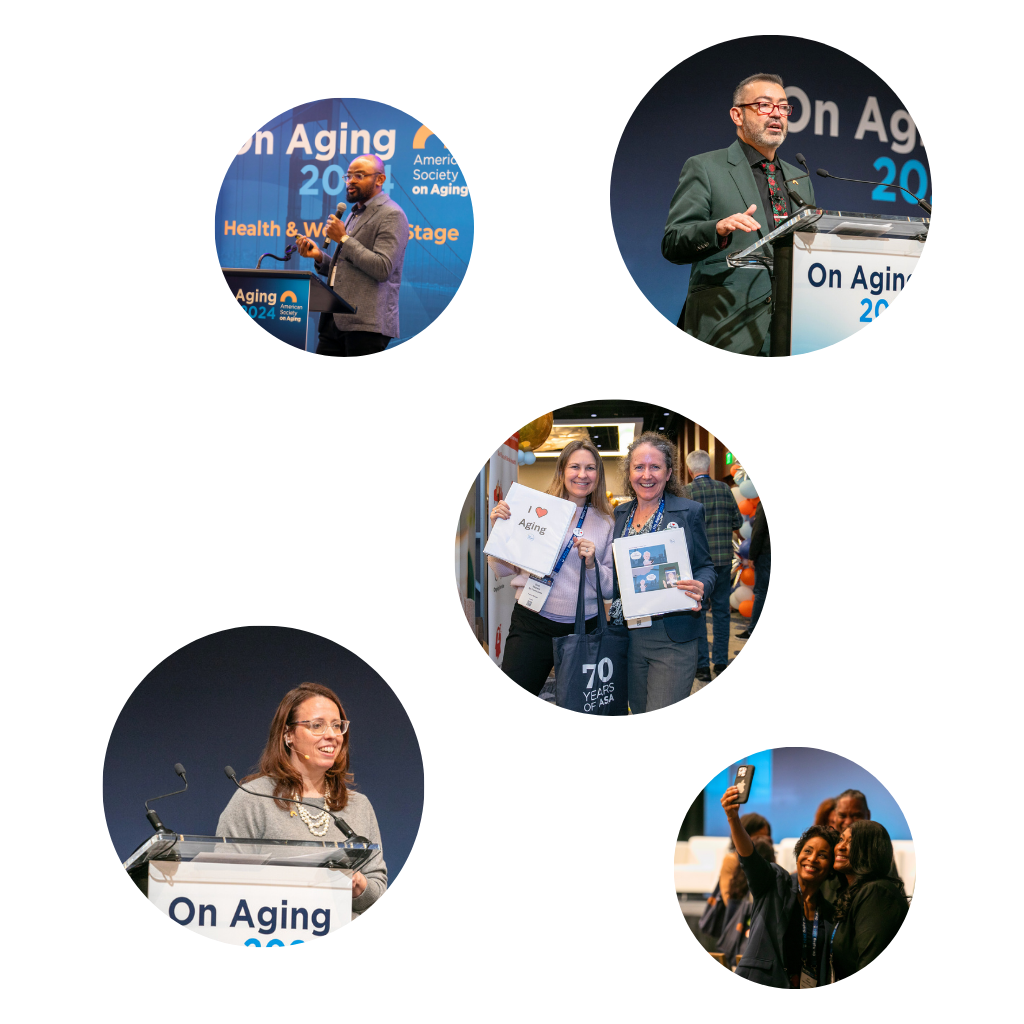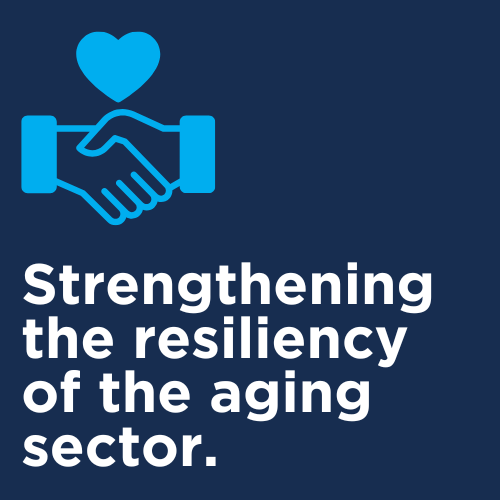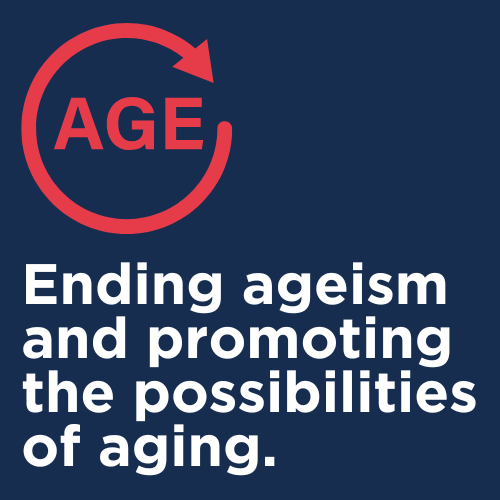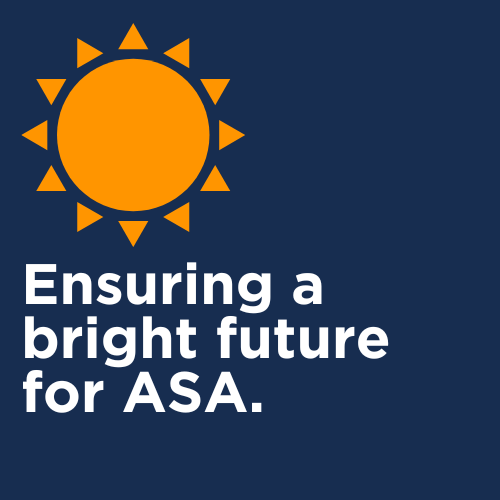Download the Strategic Plan
For your convenience, you can download a PDF version of the full Strategic Plan or a concise 1-page overview for easy reading, sharing, or printing—or explore the complete plan directly on this webpage.
Since our founding in 1954, originally as the Western Gerontological Society (WGS), the American Society on Aging has been a leading voice in championing the broad and multidisciplinary aging sector. Throughout these 70 years and still today, ASA’s members and leaders have advocated for a range of critical issues related to more equitable aging, such as bolstering physical and mental health supports for older adults, preserving Medicare and Medicaid, fighting against racism and other forces of inequality, promoting leaders of color in aging, advocating with and for LGBTQ+ communities, and much more. The threads of advocacy and innovation have been tightly woven into our mission, and they continue today in our association.
Also infused in our work is a strong belief in fostering diversity, equity and inclusion in aging. As our country’s older population continues to grow, we also are becoming increasingly diverse, which makes the fight against discrimination of all types all the more urgent. We weave equity throughout our programming and organizational structure and internal operations, elevating historically underrepresented and suppressed voices, emphasizing older adults and inspiring ASA members to foster inclusivity wherever they work or live.
ASA’s work, and that of our members, is framed around five programmatic priorities, all of which inform our educational offerings, publications and annual conference:
Ageism & Culture
Exploring cross-cultural views on aging, promoting positive portrayals of aging at the individual, community and national levels, reframing how we talk about aging and older people, shifting representations of aging in media to focus on strengths and contributions, and promoting representation of aging in the arts.
Economic Security
Examining the longevity economy, creating more education and training opportunities across the life course, promoting age-friendly work and retirement structures, reducing economic instability, and enhancing healthcare costs and aging-in-community.
Equity & Justice
Promoting elder justice, aligning with other social justice movements, spearheading diversity and inclusion initiatives, and centering the intersections between aging and racism, homophobia, gender-based and religious discrimination, and other axes of inequality in U.S. life.
Health & Well-Being
Reforming systems of care that address social determinants of health, fighting for mental health parity and outcomes, uplifting spiritual well-being, drawing attention to the role of technology and macro issues such as climate change and immigration.
Innovation & Social Impact
Highlighting age-friendly initiatives, investing in design thinking, popularizing technology that connects people of all ages, crafting innovations in service delivery, and supporting public-private-partnerships to improve our lives as we age.
We represent and engage more than 5,000 multidisciplinary leaders across the country who, broadly defined, work in the aging sector. They are advocates, practitioners, researchers, policymakers, business leaders, social workers, educators, caregivers, healthcare professionals, technologists, and legal experts. They come from nonprofits, healthcare organizations, senior living, aging services, government agencies, educational institutions, private industry, faith-based organizations, and the tech innovation sector. Some are new to aging, and others have devoted years, if not decades, to improving the lives of older adults.
We also pay close attention to bringing new leaders into the aging sector and into the fold of ASA’s membership, because the larger and more robust we are, the more powerful we’ll be in creating an equitable world in which all of us prosper as we grow older.
ASA’s 3-year Strategic Plan consolidates 18 months of extensive research, reflections, and conversations. From the summer through the fall of 2023, we held virtual “coffee chats” open to all members, met with Advisory Councils, Legacy Corps, and DEI Upstanders, and surveyed our remarkable board of directors to gather ideas and hold in-depth discussions about ASA’s value proposition, assets, and big-picture opportunities. We also reviewed and analyzed historical operating documents, financial trends, and membership survey results.
In January 2024, we synthesized what we learned into a draft plan, shared it at On Aging 2024 and through our e-newsletters and asked for reactions and feedback. We learned there was widespread support for ASA to focus on three impact areas: bolstering the field of aging; shifting cultural narratives and actions toward aging; and growing a robust, cross-sector association strong enough to endure in the long term—with equity firmly at the center of all activities. This feedback also affirmed that ASA’s most valuable asset continues to be our membership, and their enormous dedication, talent, skill, and range of interests.
The plan described is a collaborative roadmap of where we, the American Society on Aging, will go together—and how we will get there.
Our country is at a critical point in history: for the first time, people ages 60 and older will outnumber children younger than age 18. As our population continues to grow older, we will also become more diverse have realized remarkable gains in longevity as a population, this has not occurred equitably and obscures the fact that living longer does not mean living healthier. More than ever, our society understands the root causes of disparities in health, wealth and life expectancy, a knowledge base that should in theory lead to improvements in these areas, yet discrimination and its many harmful effects persists. Ageism also perseveres, affecting 1 out of every 2 people globally, with devastating harms to economies, communities and to our personal lives.
For 70 years, ASA has bolstered a broad and ever-growing network of leaders across various fields—from aging services to advocacy to academia and much more. Together, we have improved the well-being of millions of older people and their families, broadly defined. We know that while our network is ready and eager to continue helping older people thrive, too many of our organizational members are under-resourced. We also know that business and other industry leaders are instrumental to creating a world in which we can all lead longer lives and stand to gain significant social and financial returns on investments made into our aging society by prioritizing and valuing our aging society.
We are at a unique moment in our nation’s history, when conversations about aging, once reserved for academic classrooms or doctor’s offices, now appear more regularly in news outlets, in social media chatter, and in public–private sector discourse, among other areas. As the number of older people grows, so does the visibility of older public figures, interest in longevity, and attention to healthier lives across the life course. ASA is ready to embrace the opportunities—and take on the challenges—brought by our changing demographics. We will tap into the expertise and power of our members to bolster our sector and catalyze social change so that all of us can have a fair shot at a long and healthy existence.
As we chart the next 70 years of ASA’s future, our immediate work is grounded in a theory of change, illustrated below, that displays how our strategies and tactics connect to shape the field of aging, our organization and our culture. Foundational to this theory are the principles that equity must be integrated into every strategy and that older people are at its center—as experts, change agents and storytellers.
For the diverse field of professionals and students in aging to thrive, leaders across all industries need to have sufficient knowledge, skills, diversity within their ranks, positive social connections, and opportunities to make a positive impact in their respective areas.
Unite, invest in, and champion everyone striving for an equitable society in which we age.
Offer year-round, equity-centered opportunities for members to learn, teach, and collaborate:
- On Aging Institute
- On Aging Conference
- Generations Journal, Generations Today, and Generations Now publications
- Equity-centered podcast series, webinars, and libraries
A robust ecosystem that promotes equitable and long-lasting health, opportunity, and overall well-being for older adults, involving the public, nonprofit, private, and philanthropic sectors.
To build a positive cultural narrative on aging, leaders across all sectors must embrace and propagate positive perspectives on growing older, counter ageism in healthcare and the workplace, and write about the issues that impact their work and lives.
Amplify our collective voices through programs and campaigns that center member engagement, such as:
- Advisory Councils
- Ageism Awareness Day campaigns
- ASA RISE
- Connecting ASA members as experts to the press and industry
- DEI Upstanders
- Legacy Corps
- Public Policy Committee
Offer year-round, equity-centered opportunities for members to learn, teach, and collaborate:
- On Aging Institute
- On Aging Conference
- Generations Journal, Generations Today, and Generations Now publications
- Equity-centered podcast series, webinars, and libraries
Cultural change that eliminates ageism, encourages age-inclusion, and celebrates our increasingly diverse aging society, rooted in the belief that strengths and opportunities are to be tapped and celebrated as we tackle systemic challenges facing older people.
For ASA’s internal operations to thrive in the coming years, we must explore well-aligned partnership opportunities, better position our brand, further diversify and maximize our development strategy, and think creatively about new ventures and innovation.
Invite and convene individuals and organizations to partner with ASA in co-creating a healthy and equitable reality for older adults.
Build cross-sector partnerships within and outside the traditional field of aging, such as in tech, marketing, healthcare, housing and more.
Cultural change that eliminates ageism, encourages age-inclusion, and celebrates our increasingly diverse aging society, rooted in the belief that strengths and opportunities are to be tapped and celebrated as we tackle systemic challenges facing older people.
Foundational Principles
Every aspect of our work is grounded in advancing full and fair opportunities for healthy longevity for everyone. Older people are experts, agents for change and storytellers who make our work successful.
Across the following three impact areas, we strongly believe that diversity, equity and inclusion will ensure that all of ASA's members benefit equitably from our programs and resources. We also will ensure our mission encompasses the full diversity of older adults in this country, correcting a long history of exclusion and discrimination for many populations. History has taught us that community action improves people’s lives across society—a tenant that undergirds these impact areas.
Overview
The Field of Aging: Bolstering the multidisciplinary sector of professionals in aging to better support older adults.
For the aging sector to thrive, leaders everywhere need to have the right knowledge, skills, diversity, social connections and opportunities to make a positive impact in their respective areas.
Our 3-Year Goal
With increased capacity to operate, advocate, and grow, organizational and individual ASA members will be better equipped to deliver equitable, age-inclusive approaches that meet the opportunities and needs of our aging society.
Strategies
- On Aging Institute: Launch the On Aging Institute, a comprehensive space for learning and collaboration that includes courses, workshops, tools, virtual convenings, and educational resources, including a redesigned online gerontology certificate program in partnership with the University of Southern California.
- On Aging Conference: Boost employer-sponsored attendance and local and state market participation at the On Aging conference via targeted marketing and partnerships in localities and regions where the conference is hosted.
- Member Engagement: Enhance and grow key membership engagement programs, including DEI Upstanders, Legacy Corps, Advisory Councils and our Public Policy Committee, to foster active involvement that draws upon experienced leaders and helps move the needle on key reforms.
- ASA RISE: Sustain the ASA RISE leadership program, ensuring new cohorts each year, and establish local ASA RISE programs in geographic areas with high business potential.
Key Performance Indicators
- Growth in the number of existing and new ASA members who participate in the On Aging Institute and rate it as valuable.
- Growth in attendees and sectors represented at On Aging conference.
- Growth in the number, diversity, engagement and impact of ASA member-leaders.
- At least 150 ASA RISE alums are produced over three years, to continue shaping the field of aging.
Overview
The Culture: Shifting dominant narratives on aging and older adults via strength-based frames and messaging, while advancing solutions that tackle ageism.
To build a positive cultural narrative on aging, leaders everywhere must embrace strength-based perspectives on growing older, counter ageism in healthcare and in the workplace, and write about the issues that impact their work and lives.
Our 3-Year Goal
Society will increasingly consider older adults as assets and aging as filled with opportunities—finding ways to make life easier for all of us as we age.
Strategies
- Resources and Tools: Facilitate the adoption of strength-based communication frames and messages about aging among ASA members, while equipping them with resources to combat ageism—all with an intersectional lens that acknowledges older adults often hold multiple identities meriting attention and support.
- Ageism Awareness: Organize an annual Ageism Awareness Day, aligned with Op-Eds, public education campaigns on social media, and webinars.
- Generations Publications: Regularly publish ASA’s quarterly journal, bi-monthly e-magazine and weekly blog posts on a wide range of pressing aging-related topics, featuring ASA members as authors and focusing on critical unexplored issues linked to programmatic goals.
- Expert Positioning: Connect external leaders in policy, practice and the media with ASA members who are proficient in countering ageism and effectively framing aging through strength-based messages.
Key Performance Indicators
- Increased use, promotion and satisfaction with ageism resources.
- Annual growth in Ageism Awareness Day campaign reach and engagement.
- Increased member and staff engagement with journalists and strategically identified sectors such as healthcare, human resources and tech
Overview
The Organization: Creating a robust association strong enough to support generations of older people to come.
For ASA’s operations to remain stable in today’s fiscal environment, we must continue exploring well-aligned partnership opportunities, position our brand, further diversify and maximize our development strategies, and think creatively about new ventures.
Our 3-Year Goal
ASA will consistently expand its influence and reach by building an even stronger membership base, employing creative development strategies, and leveraging partnership channels—all aligned with our overarching mission.
Strategies
- Strengthening Development: Enhance ASA’s development approaches to include new pricing structures, membership initiatives, and improved diversified strategies targeting individual donors, foundations, and other philanthropic partners.
- Business Partnerships: Develop and implement new partnership and collaboration strategies that better position ASA’s brand and capabilities, maximize resources, minimize duplication, and generate revenue.
- ASA Ventures: Further position ASA as a resource for entrepreneurs to explore and test thoroughly vetted, mission-aligned innovations and investment strategies.
- Member Consulting: Establish a consulting service line in ASA that connects ASA members to external speaking engagements and technical assistance projects related to aging and longevity.
Key Performance Indicators
- Annual revenue growth and improved diversified funding streams.
- Increased partnerships with businesses and other private-sector organizations.
- Enhanced visibility of ASA members as thought leaders.
ASA would like to express our gratitude to our board of directors who lead this organization with vision and were critical in the creation of this strategic plan. Thank you!
Robert Espinoza, MPA, Chair of the Board, CEO, National Skills Coalition
Lisa Gables, Past Chair of the Board, CEO, American Academy of Physician Associates (AAPA)
Najja Orr, PhD, Chair-Elect, President & CEO, Philadelphia Corporation for Aging
Rani Snyder, MPA, Secretary, Vice President, Program, The John A. Hartford Foundation
Jeffrey Klein, MBA, Treasurer, President & CEO, Nevada Senior Services Inc.
Ginna Baik, Director of Age Tech, AOL-Yahoo
Joon Bang, CEO, Iona Senior Services
Stephen Farber, JD, MBA, CEO & Co-Founder, HealthHive, PBC
Amy Herr, MHS, Director, Health Policy, West Health
Davis Park, Senior Program Director, Los Angeles Economic Development Corporation
Vincent Tilford, President & CEO, Hannan Foundation
Melissa Tischler, MBA, Senior Partner, Innovation, Lippincott
Simona Valancuite, MBA, President & CEO, San Diego Oasis
Ben Veghte, PhD, MPA, Director, WA Cares Fund
Maria Henke, PhD (outgoing member), Senior Associate Dean of the University of Southern California Leonard Davis School of Gerontology
Joyce Walker, MSSA (outgoing member), Vice President, Community Development, PK Management
ASA members are driving positive change in aging, building a more age-inclusive society, and leading the way with our new strategic plan. Together, we’re building a future where everyone can age well.
Become a member or renew your membership today to access vital resources, connect with industry leaders, and make a lasting impact.
The American Society on Aging (ASA) convenes the nation’s largest multisector community of professionals working in aging. We are the go-to source for learning, networking, and embracing opportunity in our aging society through an equity-focused lens. Founded in 1954 as the Western Gerontological Society, over the past 70 years ASA has grown into a diverse community of more than 5,000 professionals working with and on behalf of older adults.


